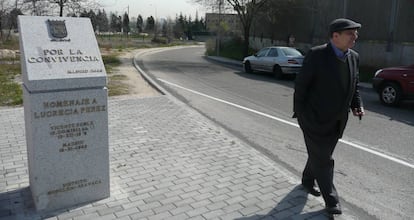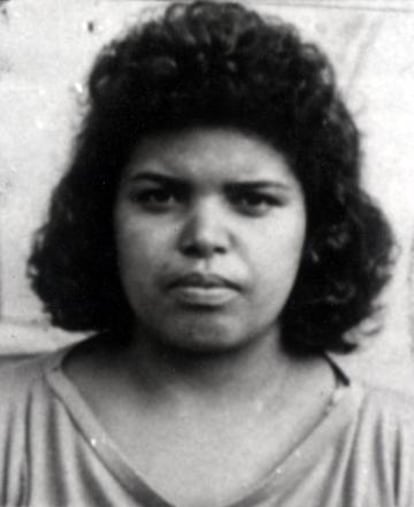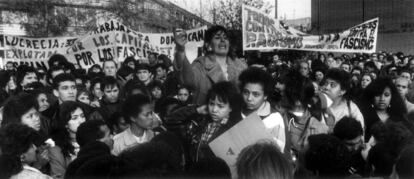Remembering Spain¡¯s first official hate crime
Twenty-five years ago, Dominican immigrant Lucrecia P¨¦rez was shot by an off-duty civil guard, bringing the subjects of immigration and racism to the forefront of Spanish society

Before driving me to the site where Lucrecia P¨¦rez was murdered, Spanish photographer Pepe Franco asked if we could stop at a mechanic. After leaving me in the driveway of his local store for a couple of minutes, Franco returned with apologies. His aging, white Peugeot had almost 300,000 kilometers on the clock and he liked to check up on it whenever he could. ¡°I don¡¯t like to change cars. It¡¯s like people for me, it¡¯s a part of my family.¡±
We drove down a country road lined with gated houses toward the edge of Aravaca, a wealthy neighborhood on the outskirts of Madrid. Our destination: an abandoned nightclub, the site where Spain¡¯s first hate crime occurred 25 years ago.
But instead of pulling over in front of an ominous discoteca, Franco stopped at a roundabout, flanked by a Ford dealership and a busy highway. A waist-high memorial sat in its center, between two benches and a couple of bare, skinny trees. ¡°Well, the disco was over here, but I think there¡¯s nothing left... I don¡¯t know, not even the bricks,¡± said Franco, who reported on the murder in 1992.
There was no trace of the abandoned nightclub where Lucrecia was killed. All that¡¯s left is her memorial
There was no trace of the abandoned nightclub where Lucrecia, an immigrant from the Dominican Republic, was killed. All that¡¯s left is her memorial. She died here, from gunshot wounds inflicted by a gang of neo-Nazis.
As the highway roared behind us, Franco pulled out an old day planner. The words ¡°Funeral Lucrecia¡± were written under the date November 18, 1992, five days after the shooting.
A Spanish magazine had published a photo Franco took at the funeral, an image of Lucrecia, wrapped in white linen in an open coffin. It took up the entire front page.

¡°They were crazy and they bought the picture,¡± said Franco. ¡°They published this picture full page, and uh...¡±
Franco lost his train of thought for a moment. ¡°I don¡¯t know. It was poor people trying to make a living here in Madrid and it was the first wave of immigrants in Madrid, probably the first.¡±
It¡¯s safe to say that if you visited Madrid recently, your tour guide wouldn¡¯t bring you here. I¡¯d bet a ca?a on it. In fact, the memorial ¨C along with Lucrecia ¨C might now be forgotten, even among the locals.
But in 1992, all of Spain knew who she was.
She was an immigrant from the Dominican Republic who signaled a new era in Spain. Her presence was proof that the country was growing, after decades without immigration. And her killing, with the service weapon of an off-duty civil guard, introduced Spain to a dark side-effect of immigration: hate crime.
It was poor people trying to make a living, and it was the first wave of immigrants in Madrid
The story of Lucrecia Per¨¦z begins in Vicente Noble, an agricultural area not far from Santo Domingo. In 1992, she left her husband and daughter for Spain¡¯s growing economy, hoping to become a housekeeper. She quickly found a job, though her employment didn¡¯t last long. Homeless and jobless, she joined a community of Dominicans who inhabited an abandoned nightclub on the edge of Madrid. Despite it being a squat house, there were beds inside and even a kitchen, according to Franco, who interviewed the residents after the killing.
But not long after she moved in, a rogue Spanish civil guard led a gang of neo-Nazis into their compound. Three of them were only teenagers. The officer started shooting randomly, injuring two of the immigrants. But Lucrecia was the only one that was killed. Just minutes before, she had been eating dinner by candlelight.

¡°Just for this: because she was poor, she was black, and she was an immigrant,¡± said Miguel Ramos, a Spanish journalist who studies hate crimes.
The perpetrators were eventually caught and convicted of murder. The Spanish media obsessively covered her story. It was made into a TV movie, and singers wrote songs about her. But that was a long time ago, and some think Lucrecia is fading from the public¡¯s collective memory. ¡°I think it¡¯s a very forgotten story,¡± said Charo Nogueira, who reported on the murder in 1992.
While the story may be forgotten, it¡¯s worth remembering today. Because within the story of Lucrecia, lies the story of modern Spain, a country that has become one of the most popular migrant destinations in Europe. According to a report released by the Migration Policy Institute, in 2015 there were 5,875,000 immigrants living in the country.
But Lucrecia¡¯s Madrid was very different. In 1992, immigrants made up just a tiny sliver of its population ¨C around 300,000, according to Joaqu¨ªn Arango, an expert on immigration and a professor of Sociology at Madrid¡¯s Complutense University.
The Spanish media obsessively covered her story. It was made into a TV movie, and singers wrote songs about her
While that number sounds small, it was actually the beginning of something big. Before that ¨C and for most of the 20th century ¨C there were practically no immigrants living in Spain. The country had suffered a brutal civil war in the 1930s, leaving it with a fascist dictator and a struggling economy. ¡°Spain was not an appealing country for migrants, even if there was economic growth since 1960 more or less,¡± said Arango, who co-authored a report on Spanish immigration for the Migration Policy Institute.
That means Lucrecia and the Dominicans she lived with were some of the first immigrants the country had seen in decades.
¡°Lucrecia¡¯s murder had shown that we had become an immigration country, a country where people from abroad were coming in order to get a job,¡± said Nogueira, a reporter for EL PA?S.
Immigration in Spain was scarce for decades, and as such, so were acts of racism. Lucrecia¡¯s murder brought hate crimes to the public¡¯s attention. It brought discussions of racism to the televisions, newspapers and homes of Spaniards. The murder was so traumatic that Nogueira thought it might have stopped future racist acts: ¡°It was like a vaccination, in my opinion.¡±

But if her murder didn¡¯t stop racism, it surely educated the nation of its existence.
Many hate crimes have taken place since Lucrecia. But her death did inspire Spaniards to organize against racism, an influence that still can be felt. It brought protests to the streets of Madrid and Barcelona. Groups such as Sos Racismo Madrid were created in response to her murder, and many are still helping immigrants in Spain today.
¡°It put a feeling into my mind that I must also fight this,¡± said Ramos, who helped create Crimenes De Odio, an extensive database of Spanish hate crimes.
Her death inspired Spaniards to organize against racism, an influence that still can be felt
¡°It really was the first time Spaniards had thought about whether they were a racist society, what that meant, who the racists were, why people were racists, what it was like to be on the other end of racism, basically start thinking of it as something that might exist domestically,¡± said Giles Tremlett, a British writer and Guardian journalist based in Madrid.
¡°This is important because what you don¡¯t measure, doesn¡¯t exist,¡± said Irene Carri¨®n ?lvarez, a member of Sos Racismo Madrid.
Tu suscripci¨®n se est¨¢ usando en otro dispositivo
?Quieres a?adir otro usuario a tu suscripci¨®n?
Si contin¨²as leyendo en este dispositivo, no se podr¨¢ leer en el otro.
FlechaTu suscripci¨®n se est¨¢ usando en otro dispositivo y solo puedes acceder a EL PA?S desde un dispositivo a la vez.
Si quieres compartir tu cuenta, cambia tu suscripci¨®n a la modalidad Premium, as¨ª podr¨¢s a?adir otro usuario. Cada uno acceder¨¢ con su propia cuenta de email, lo que os permitir¨¢ personalizar vuestra experiencia en EL PA?S.
?Tienes una suscripci¨®n de empresa? Accede aqu¨ª para contratar m¨¢s cuentas.
En el caso de no saber qui¨¦n est¨¢ usando tu cuenta, te recomendamos cambiar tu contrase?a aqu¨ª.
Si decides continuar compartiendo tu cuenta, este mensaje se mostrar¨¢ en tu dispositivo y en el de la otra persona que est¨¢ usando tu cuenta de forma indefinida, afectando a tu experiencia de lectura. Puedes consultar aqu¨ª los t¨¦rminos y condiciones de la suscripci¨®n digital.










































